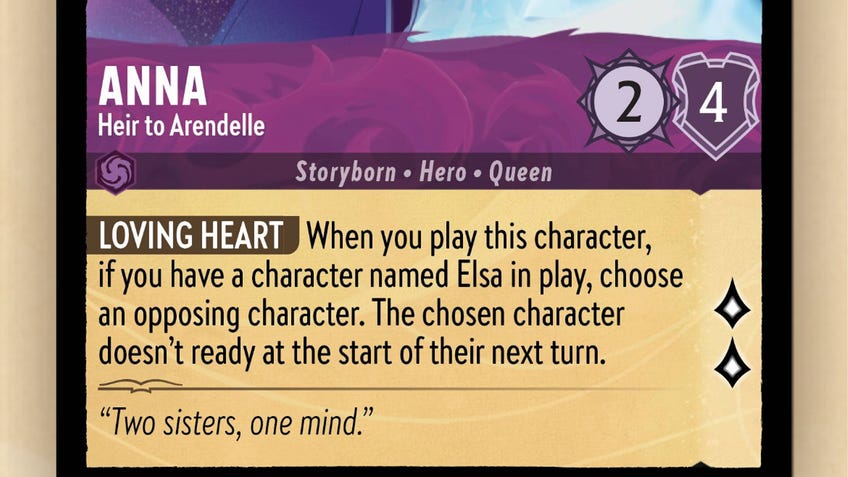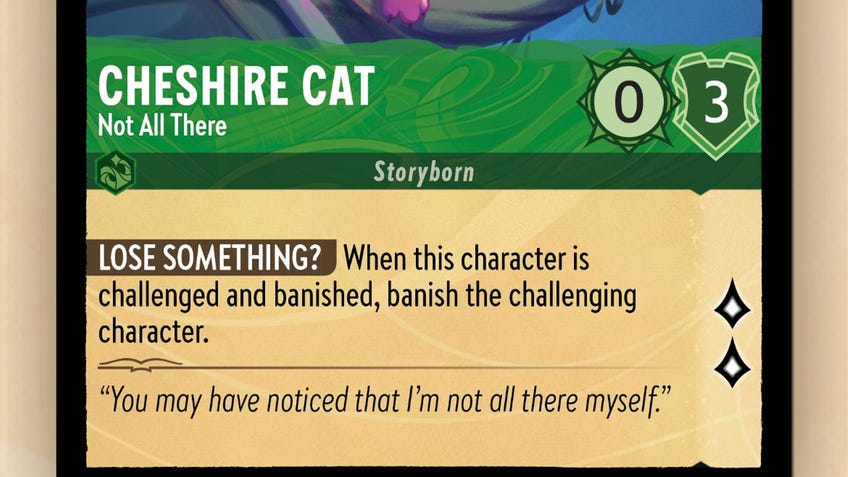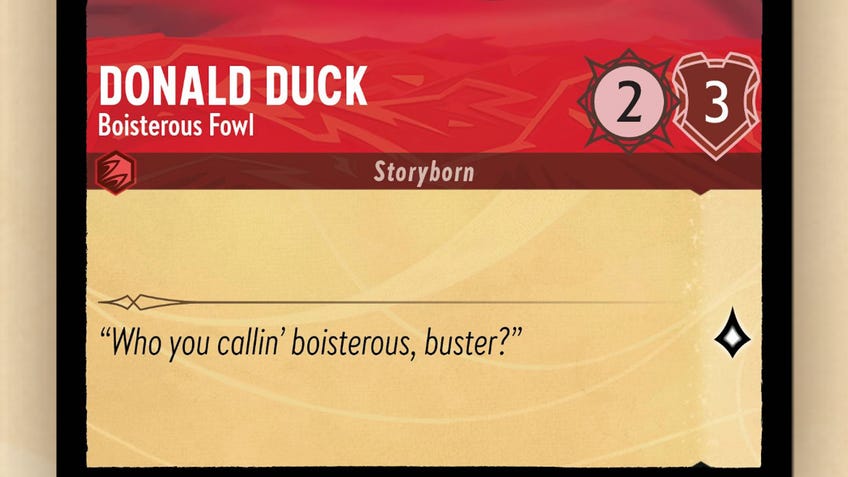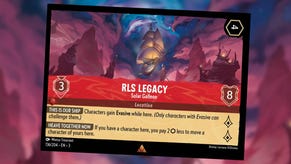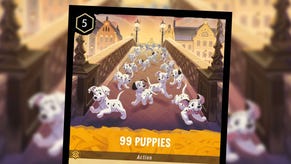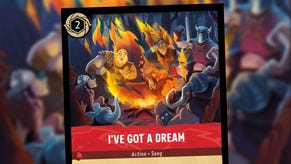How to build a Lorcana deck in the Disney TCG
Ensure your Disney Lorcana deck is up to scratch by following our guide.
Once you’ve mastered the basics of how to play Disney Lorcana, the next thing you’ll probably want to do is learn how to build a Lorcana deck. Building your own Lorcana deck allows you to experiment with the Disney TCG’s most inventive gameplay effects and strategies, as well as being a fun way to celebrate your favourite characters from the movies.
How to build a Disney Lorcana deck
- How many cards are in a Lorcana deck?
- How many copies of a card can I have in a Lorcana deck?
- How many ink colours can I include in a Lorcana deck?
- What are the ink colours in Disney Lorcana?
- What do the different ink colours do in Lorcana?
- Lorcana deck building tips
If you’re brand new to Lorcana and other trading card games, picking up one of the best Lorcana starter decks is an easy way to learn the rules without having to worry about whether you’ve picked the right cards for your deck. Building a Lorcana deck comes down to understanding how its different cards can interact and ensuring that you’ve included enough cards of different ink costs to avoid getting stuck without the ability to play anything.
The starter decks launched as part of Lorcana’s The First Chapter set have been deliberately designed to offer a balanced experience and showcase some of the different card types and effects in the game, helping you to wrap you head around how the game works and its differences from other TCGs such as Magic: The Gathering. That said, they’re also deliberately aimed at beginners, so once you know the ropes you’ll likely want to start building your own Lorcana deck to explore some of the deeper strategies on offer and ensure you remain competitive.
Below you’ll find everything you need to know about building a Lorcana deck, from Lorcana’s official deck building rules to what each ink colour represents and why you should consider including it in your deck. More than anything, remember that it’s okay to just experiment with your deck - if you want to make a deck themed around your favourite Disney movie or play around with a particular keyword or effect, that’s all part of the fun!
Disney Lorcana deck building rules
How many cards are in a Lorcana deck?
When building a Lorcana deck, you must have at least 60 cards in your deck. Those cards can include characters, item cards and action cards - including both standard actions and song cards.
While you do need at least 60 cards in total, you don’t have to include a specific number of cards of a certain type - you could have just characters, if you really want.
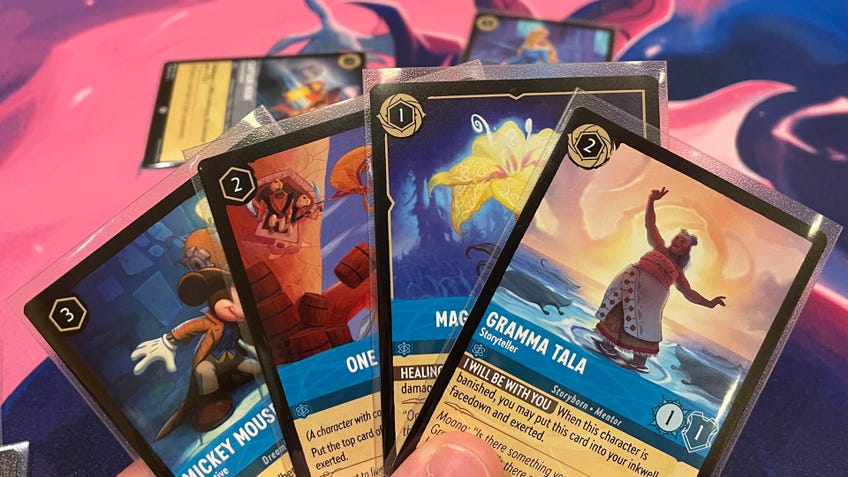
How many copies of a card can I have in a Lorcana deck?
One of the most important Lorcana deck building rules is that no card with the same name can appear more than four times in your deck.
However, the same character might appear more than four times across cards with different names - often separated by the title underneath their character name. For example, you could have four copies of both Captain Hook, Forceful Duelist and Captain Hook, Thinking a Happy Thought, as well as Captain Hook, Captain of the Jolly Roger.
It’s important to note that this rule applies based on the full name of the card, not its card number. This is particularly relevant when it comes to Enchanted variants of cards, which have unique artwork and a different card number (above 204 in The First Chapter) to their card’s original appearance. This means the Enchanted version of a card still counts towards that maximum of four if it shares the same name as another card in your deck.

How many ink colours can I include in a Lorcana deck?
You can only have up to two different ink colours in your Lorcana deck. This is presumably to ensure that decks are kept balanced, as well as encouraging variety in the card game - otherwise everyone would just include the best Lorcana cards from all six ink colours.
While two is the maximum number of different inks you can include, you can also choose to only have cards from a single ink colour, if you’re looking to build a Lorcana deck with an even more focused purpose.
What are the ink colours in Disney Lorcana?
There are six different ink colours in Lorcana. Again, when building a deck for Lorcana, you must only include up to two of the ink colours. This means you can just choose to have cards of only one ink colour in your deck, if you prefer.
A card's ink colour can be identified by looking at the symbol on the left-hand side of the card, under its name. The background colour behind its name will also reflect the card's colour.
The six ink colours in Disney Lorcana are:
What do the different ink colours do in Lorcana?
Much like the different mana colours in Magic: The Gathering, each ink colour in Disney Lorcana specialises in a different kind of gameplay style.
As you build your Lorcana deck, you’ll want to make sure that you’re picking the inks that line up with how you like to play - whether that’s aggressively challenging your opponents’ characters, questing for lore as quickly as possible, controlling the field with effects and abilities, or a mixture of one or more of these.
While some of the ink colours are shared with MTG’s mana colours, it’s important to note that their play styles don’t map across one-to-one, so it’s definitely worth learning what each of the ink colours do in Lorcana.
- Amber: Amber Lorcana cards typically specialise in supporting your characters with healing effects and protective keywords such as Bodyguard, which forces opponents to target characters with the keyword. Other supportive effects include Moana, Of Motunui’s ‘We Can Fix It’ ability, which allows you to ready other Princess characters when she quests. Pick this ink colour if you prefer to keep your characters healed and protected as you quest and challenge.
- Amethyst: Amethyst Lorcana cards include lots of magic-users, who come equipped with spells able to manipulate your opponent’s cards and slow them down. Examples include Elsa, Snow Queen’s power to ‘Freeze’, forcing an opponent’s character to be exerted. Other Amethyst cards can be helpful on your side of the board, such as Mickey Mouse, Wayward Sorcerer’s ability to animate brooms - making them cheaper to cast - and return any banished broom characters to your hand. Choose Amethyst for your deck if you like trying to control your opponent’s actions while sprinkling useful effects on yourself.
- Emerald: One of the most adaptable ink colours in Lorcana, Emerald Lorcana cards can be useful in a number of situations, from helping you to move characters between your deck, discard pile and hand, to directing your opponents’ challenges at specific characters using keywords such as Ward. Some of the best cards include Cruella De Vil, Miserable as Usual, who returns straight to your hand if banished during challenges using her ‘You’ll Be Sorry!’ ability. Emerald is the Lorcana ink to include in your deck if you like accounting for any situation that might pop up.
- Ruby: Ruby is Lorcana’s closest counterpart to Red in Magic: The Gathering. Ruby Lorcana cards hit quickly and often, specialising in aggressive challenges that aim to overwhelm your rivals with strength and send their banished characters into the discard pile. Allowing for that rapid assault are keywords such as Rush, which allows characters to challenge on the same turn they are played. If you like to take the fight right to your opponents, Ruby is the ink to have in your deck.
- Sapphire: Contrasted with Ruby’s aggression, Sapphire is the ink colour for slower and more complex decks. Cards such as Ariel, Whoseit Collector pair well with item cards, while the excellent Aurora, Dreaming Guardian grant Ward to your other characters using her ‘Protective Embrace’ power, forcing your opponents to challenge them to get them off the field. Equipped with more complicated abilities than some of the other inks, but allowing for greater card combinations and longer-term strategies as a result, Sapphire is the ink colour if you like executing a master plan across multiple turns before watching it all unfold.
- Steel: If Ruby hits fast and often, Steel is the Lorcana ink colour that hits hardest. Boasting keywords such as Challenger - which boost their strength whenever you challenge - cards such as Simba, Returned King and Maui, Demigod have some of the biggest strength and willpower numbers in the whole of Lorcana’s debut set The First Chapter. Built around a rock-solid defence and working towards unleashing massive attacks - that might take a few more turns to afford - Steel is the Lorcana ink colour for landing a one-hit KO.

Disney Lorcana deck building tips
- Follow the curve: Any card with the ink marker around its cost can be added to your inkwell and used to pay for other cards and abilities. You should make sure that your Lorcana deck balances cards you want to play that might not have an ink marker, and those that you could pay or might simply use as ink. Also make sure that you include enough cards that only cost one or two ink, so you can make sure you’re able to get characters on the field fast enough - including only expensive characters is likely to end up with you unable to defend against your opponent and lead to a quick loss. At the same time, you don’t want to only include cheap, weak characters, as you’ll then struggle to stay competitive in the later game. This arc of ensuring you can play the right cards at any point of the game is known as the curve, and is key to any Lorcana deck.
- Remember to ramp: While you can add one card to your inkwell at the beginning of each turn, including cards that allow you to add extra ink through additional effects is a helpful way to outpace your opponents and play more powerful cards as fast as possible. (This also helps to maintain that curve!) Being able to increase the resource you need to play cards and activate effects as quickly as possible is known as ‘ramping’ in the trading card game community, and is often the core of many of the strongest decks.
- Keep your options open: You only draw one card from your deck into your hand at the start of each turn. As you’re likely to be playing a card from your hand to your inkwell each turn, this means there’s a good chance you’ll start to run low on cards in your hand as you play characters, items and actions. To ensure that you have the cards you want, when you want them, having cards with the power to draw from your deck into your hand is always recommended. This is known simply as ‘card draw’, and can be achieved through specific action effects or ongoing abilities of certain characters and items. The more cards you have, the more options you have - it’s as simple as that.
- Build around your inks: With each ink in Lorcana having its own favoured play style, making sure you know how to play to their strengths is key in any good Lorcana deck. If you have a Ruby deck, be ready to challenge your opponent often - but you might have fewer chances to draw extra cards than some other colours. Sapphire, meanwhile, works best in the longer-game, so don’t rush things or you could find yourself at a disadvantage. Knowing your inks - and how they work together, if you’re using two ink colours in your deck - is vital to making your Lorcana deck the best it can be.
- You don’t need four copies of every card: While you can technically have up to four copies of any card in your deck, you don’t need to have the maximum of every card. In fact, it’s often better to limit the number of big, expensive cards you include - for the simple reason that you might not even get a chance to play them. We’d recommend limiting more expensive cards to just one or two copies, saving the room in your deck for four copies of low-cost, flexible cards that either help you work towards bigger cards or can be added to your inkwell. Having four copies of a card that costs eight ink risks you starting a game with cards you can’t afford in your hand - it’s much better to swing the odds in your favour by having a greater number of cheaper cards and surviving long enough to play those big one-off powerhouses.
Disney Lorcana is planned for release in local game stores on August 18th, ahead of a wide release on September 1st. Disney Lorcana products are available on Zatu.



